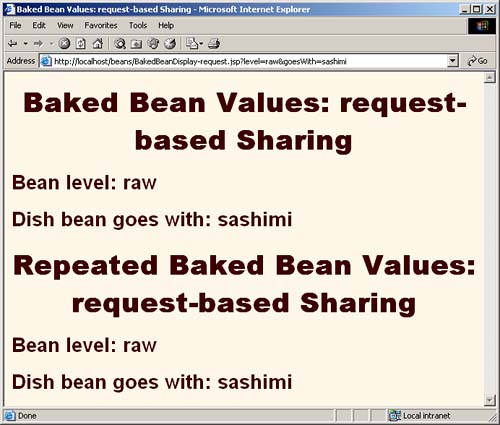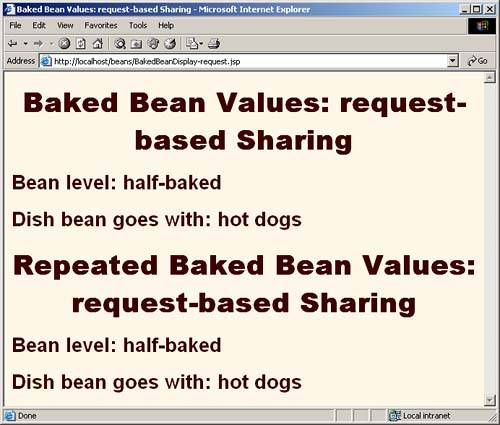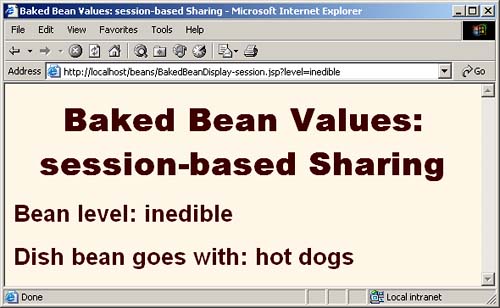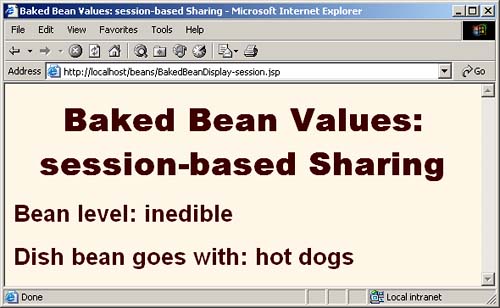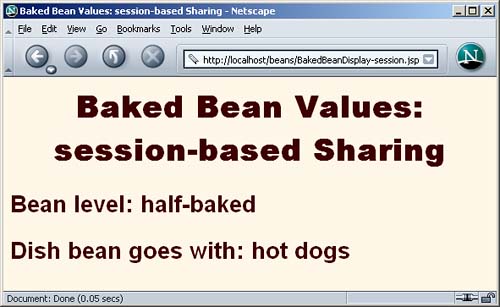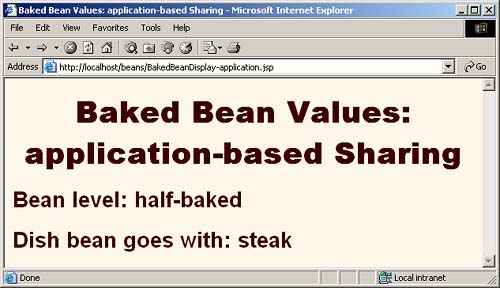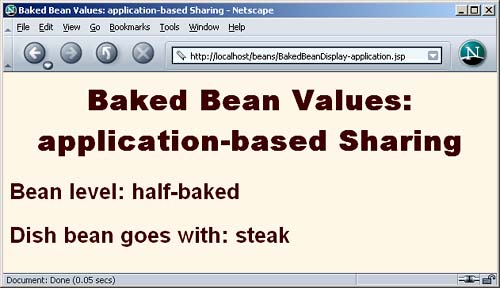14.7 Sharing Beans in Four Different Ways: An Example
| In this section, we give an extended example that illustrates the various aspects of bean use:
Before moving on to the examples, one caution is warranted. When you store beans in different scopes, be sure to use different names for each bean. Otherwise, servers can get confused and retrieve the incorrect bean. Core Warning
Building the Bean and the Bean TesterThe fundamental use of beans is as basic utility (helper) classes. We want to reiterate as strongly as possible: except for very short snippets, Java code that is directly inserted into JSP pages is harder to write, compile, test, debug, and reuse than regular Java classes. For example, Listing 14.10 presents a small Java object that represents a food item with two properties: level and goesWith (i.e., four methods : getLevel , setLevel , getGoesWith , and setGoesWith ). Perhaps this object is so simple that just looking at the source code suffices to show that it is implemented correctly. Perhaps. But how many times have you thought that before, only to uncover a bug later? In any case, a more complex class would surely require testing, so Listing 14.11 presents a test routine. Notice that the utility class represents a value in the application domain and is not dependent on any servlet- or JSP-specific classes. So, it can be tested entirely independently of the server. Listing 14.12 shows some representative output. Listing 14.10 BakedBean.java package coreservlets; /** Small bean to illustrate various bean-sharing mechanisms. */ public class BakedBean { private String level = "half-baked"; private String goesWith = "hot dogs"; public String getLevel() { return(level); } public void setLevel(String newLevel) { level = newLevel; } public String getGoesWith() { return(goesWith); } public void setGoesWith(String dish) { goesWith = dish; } } Listing 14.11 BakedBeanTest.java package coreservlets; /** A small command-line program to test the BakedBean. */ public class BakedBeanTest { public static void main(String[] args) { BakedBean bean = new BakedBean(); System.out.println("Original bean: " + "level=" + bean.getLevel() + ", goesWith=" + bean.getGoesWith()); if (args.length>1) { bean.setLevel(args[0]); bean.setGoesWith(args[1]); System.out.println("Updated bean: " + "level=" + bean.getLevel() + ", goesWith=" + bean.getGoesWith()); } } } Listing 14.12 Output of BakedBeanTest.java Prompt> java coreservlets.BakedBeanTest gourmet caviar Original bean: level=half-baked, goesWith=hot dogs Updated bean: level=gourmet, goesWith=caviar Using scope="page"No SharingOK, after (and only after) we are satisfied that the bean works properly, we are ready to use it in a JSP page. The first application is to create, modify, and access the bean entirely within a single page request. For that, we use the following:
Listing 14.13 presents a JSP page that applies these three techniques. Figures 14-6 and 14-7 illustrate that the bean is available only for the life of the page. Listing 14.13 BakedBeanDisplay-page.jsp <!DOCTYPE HTML PUBLIC "-//W3C//DTD HTML 4.0 Transitional//EN"> <HTML> <HEAD> <TITLE>Baked Bean Values: page-based Sharing</TITLE> <LINK REL=STYLESHEET HREF="JSP-Styles.css" TYPE="text/css"> </HEAD> <BODY> <H1>Baked Bean Values: page-based Sharing</H1> <jsp:useBean id="pageBean" class="coreservlets.BakedBean" /> <jsp:setProperty name="pageBean" property="*" /> <H2>Bean level: <jsp:getProperty name="pageBean" property="level" /></H2> <H2>Dish bean goes with: <jsp:getProperty name="pageBean" property="goesWith" /></H2> </BODY></HTML> Figure 14-6. Initial request to BakedBeanDisplay-page.jsp BakedBean properties persist within the page. Figure 14-7. Subsequent request to BakedBeanDisplay-page.jsp BakedBean properties do not persist between requests . Using Request-Based SharingThe second application is to create, modify, and access the bean within two different pages that share the same request object. Recall that a second page shares the request object of the first page if the second page is invoked with jsp:include , jsp:forward , or the include or forward methods of RequestDispatcher . To get the desired behavior, we use the following:
Listings 14.14 and 14.15 present a pair of JSP pages that applies these four techniques. Figures 14-8 and 14-9 illustrate that the bean is available in the second page but is not stored between requests. Listing 14.14 BakedBeanDisplay-request.jsp<!DOCTYPE HTML PUBLIC "-//W3C//DTD HTML 4.0 Transitional//EN"> <HTML> <HEAD> <TITLE>Baked Bean Values: request-based Sharing</TITLE> <LINK REL=STYLESHEET HREF="JSP-Styles.css" TYPE="text/css"> </HEAD> <BODY> <H1>Baked Bean Values: request-based Sharing</H1> <jsp:useBean id="requestBean" class="coreservlets.BakedBean" scope="request" /> <jsp:setProperty name="requestBean" property="*" /> <H2>Bean level: <jsp:getProperty name="requestBean" property="level" /></H2> <H2>Dish bean goes with: <jsp:getProperty name="requestBean" property="goesWith" /></H2> <jsp:include page="BakedBeanDisplay-snippet.jsp" /> </BODY></HTML> Listing 14.15 BakedBeanDisplay-snippet.jsp<H1>Repeated Baked Bean Values: request-based Sharing</H1> <jsp:useBean id="requestBean" class="coreservlets.BakedBean" scope="request" /> <H2>Bean level: <jsp:getProperty name="requestBean" property="level" /></H2> <H2>Dish bean goes with: <jsp:getProperty name="requestBean" property="goesWith" /></H2> Figure 14-8. Initial request to BakedBeanDisplay-request.jsp BakedBean properties |
EAN: 2147483647
Pages: 194


